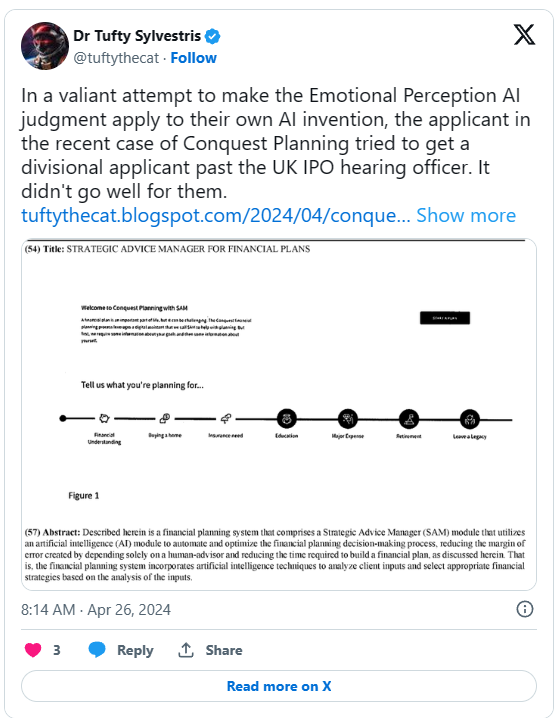Dissecting the Judgment
The English High Court’s decision in the case of Emotional Perception AI Ltd [2023] EWHC 2948 (Ch) has seemingly not attracted the critical examination one might expect from such a groundbreaking case says Tufty The Cat (aka David Pearce, a seasoned UK patent attorney). Issued on November 21, 2023, the judgment tackled the contentious issue of whether an artificial neural network (ANN) constitutes a “program for a computer” within the meaning of the Patents Act 1977.
The crux of the judgment challenges the current understanding of what constitutes a computer program in relation to patent law, as detailed in section 1(2) of the Patents Act 1977. The High Court’s decision has seemingly diverged from both higher-level case law in the UK and established case law at the European Patent Office (EPO).
The assertion that an ANN might not be classified as a computer program has sparked speculation and enthusiasm among certain circles that this could herald a new era of patentability for AI inventions. Following the ruling, the UK Intellectual Property Office (UK IPO) has adapted its practices, instructing examiners to no longer raise objections for inventions involving an ANN on the grounds of excluded subject matter, a significant shift as of November 29, 2023.
There have been several articles published that have, rather excitedly, announced the judgment as some kind of breakthrough for AI inventions because it finds, in effect, that a trained artificial neural network (ANN) is not a program for a computer under section 1(2) of the Patents Act 1977. This is, of course, in reality complete nonsense.
Tufty the Cat blog
Between the Lines: AI and Patent Law
Despite the significance of the ruling, the initial silence from intellectual property commentary platforms like IPKat leaves the case analysis to a few. There’s a notion that the judgment stands as an outlier when juxtaposed with established case law from both the UK’s Court of Appeal and the EPO’s landmark rulings.
The Ripple Effect in Patent Offices
In response to the ruling, the UK Intellectual Property Office (UK IPO) adapted its guidelines, prompting a wave of tentative celebration among AI developers and patent attorneys, who perceived the judgment as ushering in an era of increased patentability for AI-based inventions. However, the observer expresses skepticism regarding the longevity and practical implications of this deviation, predicting it might be a fleeting aberration rather than a lasting shift in patent law.
The Technicality of Technology
The core of the debate delves into the legal and technical aspects of ANNs. There’s a crucial distinction made in the ruling regarding the operational nature of ANNs that challenges the conventional classification of software, raising fundamental questions about the technical contribution and patent exclusions of such AI systems.
The discussion brings to light the nuanced and often complex nature of defining what constitutes a ‘technical effect’ or ‘technical contribution’ in the realm of computer-implemented inventions. The Aerotel/Macrossan test and the subsequent ‘signposts’ developed in AT&T/CVON and affirmed by the Court of Appeal in HTC v Apple are instrumental in guiding this determination. These tests seek to ascertain whether a contribution lies solely within excluded matter such as a computer program and, if not, whether it is truly technical in nature.
Another Viewpoint
In a recent article, patent litigator Rebecca Lawrence delved into the intricacies of patenting AI-related innovations. She highlights how the UK patent system, established in the 1970s, didn’t anticipate the complexities of AI and now must adapt. The key challenge is whether AI innovations can be patented given they often involve computer programs and mathematical methods, traditionally excluded from patentability.
The Emotional Perception AI Ltd v Comptroller-General of Patents case is a watershed, suggesting a shift towards a more AI-friendly patent regime, she claims. It focuses on the “technical effect” AI must exhibit to be patentable, she continues. The case has led the UKIPO to amend their examination practice, signaling an immediate change in handling AI inventions, specifically Artificial Neural Networks (ANNs). This represents a significant stride in recognizing the technical contributions of AI beyond mere computer programs.
Lawrence posits that while this High Court decision is progressive, comprehensive legislative updates may still be needed to fully embrace AI within patent law. According to her, the complexities of AI demand a reevaluation of the legal framework to ensure innovative AI systems receive adequate protection, aligning legal practice with the rapid advancements in technology.
A Legal Fork in the Digital Road?
While the court’s verdict may appear as a breakthrough for AI patentability, there’s skepticism about its long-term sustainability. Experts familiar with the case law suggest that this may be a temporary departure from established principles, questioning the ruling’s technical and legal grounding.
This High Court case and the subsequent reactions underscore the complex interplay between rapid technological advances and the evolution of intellectual property laws. The industry and legal observers await with bated breath to see how future rulings will further shape this ever-evolving legal framework around AI and patentability.
Author Profile

- Lucy Walker covers finance, health and beauty since 2014. She has been writing for various online publications.
Latest entries
- June 30, 2025NewsWireBank Savings at Risk: The Dark Side of EU’s Savings Standard
- April 25, 2025Global EconomicsWhistleblowers Unmask Schwab’s Toxic WEF Secrets
- April 9, 2025Global EconomicsTariff Tensions Drive Market Volatility
- March 18, 2025Global EconomicsRed in Name Only: Labour’s War on the UK Working Class





